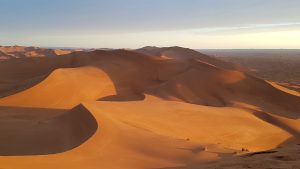16 North Africa & the Middle East: Physical Geography I –
Types of Deserts
Of course, North Africa and the Middle East (NAME) is a region known for its deserts. If a random person on the street is asked to visualize a desert in North Africa and the Middle East, he/she likely will see a hot, sandy desert in their mind’s eye. He/she will state that they are thinking of the Sahara Desert. All well and good, sometimes. However, while that may be the stereotypical desert, it is not the only type of desert in the world nor in NAME. Additionally, while the Sahara Desert is the largest desert in the world, it is in North Africa, whereas there are other deserts in the Middle East.
Deserts can be classified in four main ways:
- Hot and dry
- Semi-arid
- Coastal
- Cold
Although most countries in NAME do have coastlines, that fact alone is insufficient to create coastal deserts. Most of NAME is between the equator and 30° N latitude and demonstrates the hot and dry type of deserts.

Photo by Noah Bikoro on Unsplash.
In the hot and dry category, the stereotypical sandy desert is called erg. This desert has wind-blown sand over a broad expense. Often, wind patterns have build sand dunes in erg deserts, though occasionally erg deserts will lack dunes. Sand sheets are these erg deserts without dunes. Sections of the Sahara Desert feature erg landscapes, but the Sahara is not a uniform desert. Rather, the Sahara contains a few different types of desert landscapes. One of the larger sand dune areas in the Sahara is the Issaouane Erg, covering about fifteen thousand square miles.
In the Middle East, the Rub’ al-Khali is this stereotypical erg desert. Translated as “the Empty Quarter,” this erg desert is vast at about a quarter million square miles, covering territory in Saudi Arabia, Yemen, and Oman. Due to the extremes of sand dunes amid scorching heat (117°F daily average highs in July and August) and hyperarid conditions (1.4 inches rain per year), the land is nearly empty of people.
Sand dunes themselves are not uniform, but are in different categories. Barchan dunes are crescent-shaped and result from unidirectionally facing the wind. Often strong winds push the sand upward into dunes, but smaller amounts of sand may push past the edges of the dune in part extending like tails, helping to create the crescent shapes. The main portions of barchan dunes has asymmetrical sides, being steeper on the side pushed by the wind.

Photo by Remi Moebs on Unsplash.
Sometimes confused with barchan dunes are parabolic dunes that often appear to have similar shapes. Parabolic dunes feature sand mixed with vegetation. The holding power of the vegetation essentially reverses that dunes’ patterns. Parabolic dunes may form from mixed wind patterns, but the primary winds work in opposition to the shaping winds of barchan dunes. The tails of parabolic dunes show the direction from which the wind flows toward the heights of the dunes.
Linear dunes obviously do not have crescent shapes but are formed from limited sand and in rough lines across the landscape, but where the wind direction and the linear direction matches.
Transverse dunes may be confused with linear dunes, again as wavy lines across the landscape. However, in the case of transverse dunes the wind flow is counterintuitively perpendicular to the wavy lines. The (above on the right side of the page) image of erg desert in Dubai displays transverse dunes.
Reg in western Sahara (but serir in eastern Sahara) is another common type of desert landscape, sometimes called desert pavement. Erg deserts are noteworthy for their lack of sand. Instead the surface is hard packed and mixed with small stones and pebbles.
Hamada landscapes also have limited amounts of sand, but display weathered bedrock with fewer pebbles than in an reg desert. Hamada often is in a somewhat elevated, perhaps plateau setting. Qatar features quite a bit of hamada landscape.
So, while the popular view of deserts is that of hot burning sun blazing down onto vast dunes of wavy sand, that is not uniformly true of deserts around the world nor in NAME. The Sahara Desert does hold these sand dune desert lands, but also reg and hamada territory. On the Arabian Peninsula, the Rub’ al-Khali best matches our described stereotypical desert, but other desert land persist in the Middle East too.
Overall, deserts are dry and NAME has lots of varied land that meets that one criterion.
Did you know?
The planet Mars features a few ergs.
Numerous desert words come from the Arabic language – erg, reg, hamada. Curiously, the word barchan is borrowed from Russian бархан meaning sand dune.
In 2020, desert explorer Max Calderan became the first person to cross the Rub’ al-Khali alone and unaided. Walking, it took him sixteen days.
Cited and additional bibliography:
“Barchan Landforms – Crescentic Dune | Type of Sand Dune.” http://worldlandforms.com/landforms/barchan/ .
Kollegger, Madeline and Grunert, Taylore. “Major Types of Dunes: Where and How They Form.” Sedimentology and Stratigraphy. University of Connecticut, Geosciences. February 7, 2017. https://sedimentology.uconn.edu/2017/02/07/major-types-of-dunes-where-and-how-they-form/ .


